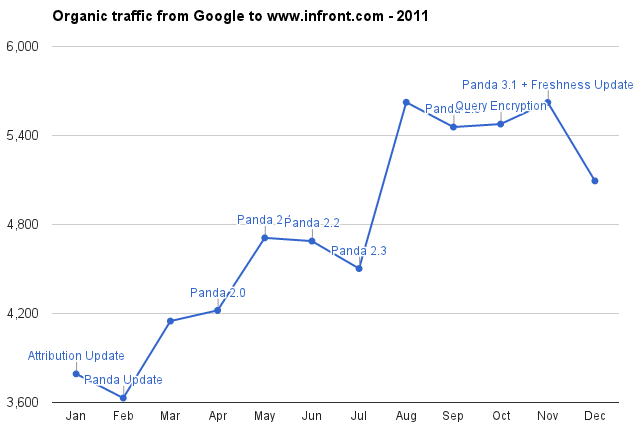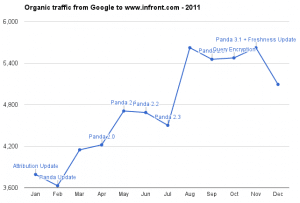One of the hardest concepts for people to grasp when considering SEO is the fact that search engine rankings are not “static,” and that your website’s rankings for a particular search term may go up or down over time. Usually, the amount of traffic you get from a search engine changes when your website’s ranking changes, so it’s reasonable for people to be concerned about ranking changes that affect their website.
Sometimes, potential clients come to Infront for internet marketing and they’ll say something like “I need help with my website. I can’t understand what happened… My website used to be number one, and now it isn’t anymore—I didn’t make any changes to my site.“
Since most people don’t even understand how websites are ranked in the first place, I usually have to start by explaining the basics (i.e. content, relevance, freshness, on-page factors, off-page factors, website structure, inbound links, etc), and then I talk about the algorithm that Google uses to determine these factors, and it’s almost always a surprise to them when I say that the algorithm is updated from time to time.
Actually, it’s updated over 500 times a year, so it’s an understatement to say that your website’s rankings can change occasionally. While most of these algorithm changes are minor, there are a few are big, drastic modifications made sometimes that can really affect the way your website ranks in search results. In 2011, for example, there were over 11 major algorithm changes that affected traffic to a lot of websites.
To give you an idea, below is a chart of all the search traffic that our website received in 2011, overlaid with the algorithm updates (and their names) plotted by month.

Our website gets a lot of organic traffic, and it was affected by a few of these updates. If I had enough time to drill down deep and do lots of research, I could figure out the exact day the algorithm updates were made, what they accomplished, and how we could respond to those changes. But for this post, let’s just look at it in a general sense.
Notice that after February, when “Panda” first came out, our traffic grew, so in this case, it helped us. (If you’ve ever heard SEOs complaining about the Panda update and didn’t know what it was all about, here’s the basic idea: Google was focusing on penalizing websites with low-value content, sometimes called “content farms”). So it could be Google liked the content we had on our website and rewarded us for it.
After Panda 2.0, it would appear we were given another boost, as our organic search traffic rose a second time. Panda 2.2, on the other hand, may have caused the small decrease you’ll see in June. But right after that, Panda 3.3 appears to have given us significant lift. You can see how the rest of the year plays out; after August, it’s pretty solid until the “Freshness Update” in November where we see a decrease, but that’s more likely just a seasonal dip towards the end of the year.
So you can see that certain algorithm changes can impact your traffic, either for good or bad. Part of the benefit of hiring an SEO firm to boost your organic search engine rankings is that you have someone available to A) tell you about these updates, B) tell you when they happen, and C) respond to them quickly to keep your search traffic coming in. But at a bare minimum, just know that search engine traffic is not a constant; that search engines results rankings are not guaranteed; and that everything can change.
If you’re curious about how your own website has fared during the recent algorithm updates, just Contact us and I’ll be happy to help you analyze your traffic. Until then, go, and dominate the interwebs!

Allan Todd is CEO of Pagecafe Digital Marketing. In 2022, Allan teamed up with Infront Webworks to provide digital marketing, website design, content marketing, SEO and strategy and solutions to local businesses. Allan lives in Colorado Springs.


